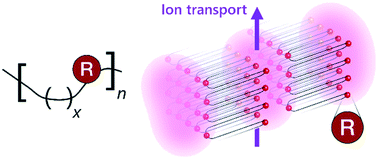Nanoscale layers in polymers to promote ion transport†
Abstract
Polymer membranes with enhanced charge transport properties would enable solid-state batteries with improved safety, increased lifetime, and decreased cost. However, the ion conductivity of polymers remains low after decades of research. Here, we advocate for an alternative design strategy for ion-conducting polymers, wherein a precisely periodic chemical microstructure leads to backbone crystallization, controlled hairpin chain folding at the position of each functional group, and ordered layers of sub-nanometer thickness that function as pathways for charge transport. This chain-folded layered structure is observed in a linear polyethylene with sulfonic acid groups pendant to precisely every 21st carbon atom, and the membrane exhibits high proton conductivity at high humidity, matching the benchmark membrane Nafion 117. We discuss related instances of ion and proton transport through thin layers in polymers, as well as other examples of controlled polymer folding leading to ordered nanoscale layers. We also propose design rules for achieving the chain-folded layered structure in new polymers. This layered structure has the potential for improved charge transport relative to amorphous polymers, representing a significant advance in ion-conducting polymer membranes.

- This article is part of the themed collection: Charge Transporting Nanostructured Polymers for Electrochemical Systems


 Please wait while we load your content...
Please wait while we load your content...